Beyond Bird Feed: Proso Millet for Human Health and Environment
Abstract
1. Introduction
2. Methodology
3. Proso Millet for Climate-Change
3.1. Drought
3.2. Marginal and Degraded Soil
3.3. High Temperature
3.4. Rotational Crop
4. Proso Millet as Human Food and Health Benefits
5. Proso Millet vs. Quinoa
Price Hike and Ecosystem
6. Proso Millet Based Foods and Beverages across the World
6.1. Porridge and Steamed Food
6.2. Bakery Products
6.3. Fermented Products and Beverages
7. Bioethanol
8. Socio-Economic Aspect of Millet
9. Future Prospect and Perspectives
Author Contributions
Funding
Acknowledgments
Conflicts of Interest
References
- Habiyaremye, C.; Matanguihan, J.B.; D’Alpoim Guedes, J.; Ganjyal, G.M.; Whiteman, M.R.; Kidwell, K.K.; Murphy, K.M. Proso Millet (Panicum miliaceum L.) and Its Potential for Cultivation in the Pacific Northwest, U.S.: A Review. Front. Plant Sci. 2017, 7. [Google Scholar] [CrossRef] [PubMed]
- Dwivedi, S.; Upadhyaya, H.; Senthilvel, S.; Hash, C.; Fukunaga, K.; Diao, X.; Santra, D.; Baltensperger, D.; Prasad, M. Millets: Genetic and Genomic Resources. In Plant Breeding Reviews; John Wiley & Sons, Inc.: Hoboken, NJ, USA, 2011; pp. 247–375. [Google Scholar]
- Amadoubr, I.; Le, M.; Le, G.-W. Millets: Nutritional composition, some health benefits and processing—A Review. Emir. J. Food Agric. 2013, 25, 501–508. [Google Scholar] [CrossRef]
- FAOSTAT. Data on millet producing countries. 2016. Available online: http://www.fao.org/faostat/en/#data/QC/visualize (accessed on 22 December 2018).
- U.S. National Plant Germplasm System Taxonomy: Panicum miliaceum L. Available online: https://npgsweb.ars-grin.gov/gringlobal/taxonomydetail.aspx?id=317710 (accessed on 11 December 2018).
- Sheahan, C.M. Plant Guide for Proso Millet (Panicum miliaceum); USDA-Natural Resources Conservation Service: Cape May Plant Materials Center, Cape May, NJ, USA, 2014.
- Lu, H.; Zhang, J.; Liu, K.; Wu, N.; Li, Y.; Zhou, K.; Ye, M.; Zhang, T.; Zhang, H.; Yang, X.; et al. Earliest domestication of common millet (Panicum miliaceum) in East Asia extended to 10,000 years ago. Proc. Natl. Acad. Sci. USA 2009, 106, 7367–7372. [Google Scholar] [CrossRef] [PubMed]
- Santra, D.K. Proso Millet Varieties for Western Nebraska. NebGuide, University of Nebraska-Lincoln, G2219. 2013. Available online: http://extensionpublications.unl.edu/assets/pdf/g2219.pdf (accessed on 22 December 2018).
- Lyon, D.J.; Burgener, P.A.; DeBoer, K.L.; Hein, G.L.; Hergert, G.W.; Holmon, T.L.; Nelson, L.A. Proso Millet in the Great Plains. University of Nebraska-Lincoln, Extension Article EC137. 2008. Available online: http://extensionpublications.unl.edu/assets/pdf/ec137.pdf (accessed on 22 December 2018).
- Habiyaremye, C.; Barth, V.; Highet, K.; Coffey, T.; Murphy, K.; Habiyaremye, C.; Barth, V.; Highet, K.; Coffey, T.; Murphy, K.M. Phenotypic Responses of Twenty Diverse Proso Millet (Panicum miliaceum L.) Accessions to Irrigation. Sustainability 2017, 9, 389. [Google Scholar] [CrossRef]
- Nielsen, D.C.; Vigil, M.F. Water use and environmental parameters influence proso millet yield. Field Crops Res. 2017, 212, 34–44. [Google Scholar] [CrossRef]
- USDA-NASS Crop Production 2015 Summary. USDA, 2016. Available online: https://www.usda.gov/nass/PUBS/TODAYRPT/cropan16.pdf (accessed on 22 December 2018).
- Awika, J.M. Major Cereal Grains Production and Use around the World. In Advances in Cereal Science: Implications to Food Processing and Health Promotion; American Chemical Society: Washington, WA, USA, 2011; pp. 1–13. [Google Scholar]
- Sharma, C.P. Overdraft in India’s Water Banks: Studying the Effect of Production of Water Intensive Crops on Groundwater Depletion; Georgetown University: Washington, DC, USA, 2016. [Google Scholar]
- Kumar, A.; Tomer, V.; Kaur, A.; Kumar, V.; Gupta, K. Millets: A solution to agrarian and nutritional challenges. Agric. Food Secur. 2018, 7, 31. [Google Scholar] [CrossRef]
- FAO. Drought and Agriculture. Available online: http://www.fao.org/land-water/water/drought/droughtandag/en/ (accessed on 11 December 2018).
- MacDonald, G.M. Water, climate change, and sustainability in the southwest. Proc. Natl. Acad. Sci. USA 2010, 107, 21256–21262. [Google Scholar] [CrossRef]
- Tadele, Z. Drought Adaptation in Millets. In Abiotic and Biotic Stress in Plants—Recent Advances and Future Perspectives; InTech: London, UK, 2016. [Google Scholar]
- Blum, A. Drought resistance, water-use efficiency, and yield potential—Are they compatible, dissonant, or mutually exclusive? Aust. J. Agric. Res. 2005, 56, 1159. [Google Scholar] [CrossRef]
- Monneveux, P.; Jing, R.; Misra, S.C. Phenotyping for drought adaptation in wheat using physiological traits. Front. Physiol. 2012, 3, 429. [Google Scholar] [CrossRef] [PubMed]
- Fang, Y.; Xiong, L. General mechanisms of drought response and their application in drought resistance improvement in plants. Cell. Mol. Life Sci. 2015, 72, 673–689. [Google Scholar] [CrossRef] [PubMed]
- Vivitha, P.; Vijayalakshmi, D. Minor millets as model system to study C 4 photosynthesis—A review. Agric. Rev. 2015, 36, 296–304. [Google Scholar] [CrossRef]
- Kafi, M.; Zamani, G.; Ghoraishi, S.G. Relative salt tolerance of south Khorasan millets. Desert 2009, 14, 63–70. [Google Scholar]
- Hamdy, A.; Ragab, R.; Scarascia-Mugnozza, E. Coping with water scarcity: Water saving and increasing water productivity. Irrig. Drain. 2003, 52, 3–20. [Google Scholar] [CrossRef]
- Saxena, R.; Vanga, S.; Wang, J.; Orsat, V.; Raghavan, V.; Saxena, R.; Vanga, S.K.; Wang, J.; Orsat, V.; Raghavan, V. Millets for Food Security in the Context of Climate Change: A Review. Sustainability 2018, 10, 2228. [Google Scholar] [CrossRef]
- Gregory, P.J.; George, T.S. Feeding nine billion: The challenge to sustainable crop production. J. Exp. Bot. 2011, 62, 5233–5239. [Google Scholar] [CrossRef] [PubMed]
- Davies, W.J.; Bennett, M.J. Achieving more crop per drop. Nat. Plants 2015, 1, 15118. [Google Scholar] [CrossRef] [PubMed]
- Ceccarelli, S.; Grando, S. Drought as a challenge for the plant breeder. Plant Growth Regul. 1996, 20, 149–155. [Google Scholar] [CrossRef]
- Baltensperger, D.; Lyon, D.; Anderson, R.; Holman, T.; Stymiest, C.; Shanahan, J.; Nelson, L.; Deboer, K.; Hein, G.; Krall, J. Producing and Marketing Proso Millet in the High Plains; University of Nebraska-Lincoln Extension: Lincoln, MI, USA, 1995. [Google Scholar]
- Shantz, H.; Piemeisel, L.N. The water requirement of Plants at Akron, Colorado. J. Agric. Res. 1927, 34, 1093–1190. [Google Scholar]
- McDonal, S.; Hofsteen, L.; Downey, L. Crop Profile for Proso Millet in Colorado; Colorado State University: Fort Collins, CO, USA, 2003; Available online: https://bit.ly/2tFOWNL (accessed on 22 December 2018).
- Seghatoleslami, M.J.; Kafi, M.; Majidi, E. Effect of drought stress at different growth stages on yield and water use efficiency of five proso millet (Panicum miliaceum L.) Genotypes. Pak. J. Bot. 2008, 40, 1427–1432. [Google Scholar]
- Matsuura, A.; Tsuji, W.; An, P.; Inanaga, S.; Murata, K. Effect of Pre- and Post-heading Water Deficit on Growth and Grain Yield of Four Millets. Plant Prod. Sci. 2012, 15, 323–331. [Google Scholar] [CrossRef]
- Emendack, Y. Mid-Season water stress on yield and water use of millet (Panicum miliaceum) and sorghum (Sorghum bicolour L. Moench). Aust. J. Crop Sci. 2011, 5, 1486–1492. [Google Scholar]
- Roberts, D. This Graphic Explains Why 2 Degrees of Global Warming Will Be Way Worse Than 1.5. Available online: https://www.vox.com/energy-and-environment/2018/1/19/16908402/global-warming-2-degrees-climate-change (accessed on 13 December 2018).
- Shanahan, J.F.; Anderson, R.L.; Greb, B.W. Productivity and Water Use of Proso Millet Grown under Three Crop Rotations in the Central Great Plains. Agron. J. 1988, 80, 487–492. [Google Scholar] [CrossRef]
- Felter, D.G.; Lyon, D.J.; Nielsen, D.C. Evaluating Crops for a Flexible Summer Fallow Cropping System. Agron. J. 2006, 98, 1510–1517. [Google Scholar] [CrossRef]
- Nielsen, D.C.; Vigil, M.F. Soil Water Extraction for Several Dryland Crops. Agron. J. 2018, 110, 1–9. [Google Scholar] [CrossRef]
- Rasmussen, P.E.; Albrecht, S.L.; Smiley, R.W. Soil C and N changes under tillage and cropping systems in semi-arid Pacific Northwest agriculture. Soil Tillage Res. 1998, 47, 197–205. [Google Scholar] [CrossRef]
- Baltensperger, D.D. Foxtail and Proso Millet. In Progress in New Crops; Janick, J., Ed.; ASHS Press: Alexandria, VA, USA, 1996; pp. 182–190. [Google Scholar]
- Anderson, R.L.; Bowman, R.A.; Nielsen, D.C.; Vigil, M.F.; Aiken, R.M.; Benjamin, J.G. Alternative Crop Rotations for the Central Great Plains. J. Prod. Agric. 1999, 12, 95. [Google Scholar] [CrossRef]
- Wright, S.F.; Anderson, R.L. Aggregate stability and glomalin in alternative crop rotations for the central Great Plains. Biol. Fertil. Soils 2000, 31, 249–253. [Google Scholar] [CrossRef]
- Saleh, A.S.M.; Zhang, Q.; Chen, J.; Shen, Q. Millet Grains: Nutritional Quality, Processing, and Potential Health Benefits. Compr. Rev. Food Sci. Food Saf. 2013, 12, 281–295. [Google Scholar] [CrossRef]
- Kalinova, J.; Moudry, J. Content and quality of protein in proso millet (Panicum miliaceum L.) varieties. Plant Foods Hum. Nutr. 2006, 61, 45–49. [Google Scholar] [CrossRef]
- Devi, P.B.; Vijayabharathi, R.; Sathyabama, S.; Malleshi, N.G.; Priyadarisini, V.B. Health benefits of finger millet (Eleusine coracana L.) polyphenols and dietary fiber: A review. J. Food Sci. Technol. 2014, 51, 1021–1040. [Google Scholar] [CrossRef]
- Mcsweeney, M. Proso Millet as an Ingredient in Foods Common to North Americans; University of Guelph: Guelph, ON, Canada, 2014. [Google Scholar]
- Turer, A.T.; Scherer, P.E. Adiponectin: Mechanistic insights and clinical implications. Diabetologia 2012, 55, 2319–2326. [Google Scholar] [CrossRef] [PubMed]
- Nigro, E.; Scudiero, O.; Monaco, M.L.; Palmieri, A.; Mazzarella, G.; Costagliola, C.; Bianco, A.; Daniele, A. New Insight into Adiponectin Role in Obesity and Obesity-Related Diseases. BioMed Res. Int. 2014, 1–14. [Google Scholar] [CrossRef] [PubMed]
- Park, K.O.; Ito, Y.; Nagasawa, T.; Choi, M.-R.; Nishizawa, N. Effects of Dietary Korean Proso-Millet Protein on Plasma Adiponectin, HDL Cholesterol, Insulin Levels, and Gene Expression in Obese Type 2 Diabetic Mice. Biosci. Biotechnol. Biochem. 2008, 72, 2918–2925. [Google Scholar] [CrossRef]
- Rosenson, R.S.; Brewer, H.B.; Barter, P.J.; Björkegren, J.L.M.; Chapman, M.J.; Gaudet, D.; Kim, D.S.; Niesor, E.; Rye, K.-A.; Sacks, F.M.; et al. HDL and atherosclerotic cardiovascular disease: Genetic insights into complex biology. Nat. Rev. Cardiol. 2017, 15, 9–19. [Google Scholar] [CrossRef] [PubMed]
- Fasano, A. European and North American populations should be screened for celiac disease. Gut 2003, 52, 168–169. [Google Scholar] [CrossRef] [PubMed]
- Hulse, J.H.; Laing, E.M.; Pearson, O.E. Sorghum and the Millets: Their Composition and Nutritive Value; Academic Press: Cambridge, MA, USA, 1980. [Google Scholar]
- Ragaee, S.; Abdel-Aal, E.S.M.; Noaman, M. Antioxidant activity and nutrient composition of selected cereals for food use. Food Chem. 2006, 98, 32–38. [Google Scholar] [CrossRef]
- Zhang, L.; Liu, R.; Niu, W. Phytochemical and antiproliferative activity of proso millet. PLoS ONE 2014, 9, e104058. [Google Scholar] [CrossRef] [PubMed]
- Coulibaly, A.; Kouakou, B.; Chen, J. Phytic Acid in Cereal Grains: Structure, Healthy or Harmful Ways to Reduce Phytic Acid in Cereal Grains and Their Effects on Nutritional Quality. Am. J. Plant Nutr. Fertil. Technol. 2011, 1, 1–22. [Google Scholar] [CrossRef]
- Bhide, G. Millets for the Healthy Gut. Available online: http://www.difodin.com/blog/post/10-millets-for-the-healthy-gut-.html (accessed on 27 January 2019).
- FAO. Sorghum and Millets in Human Nutrition. Available online: http://www.fao.org/docrep/t0818e/T0818E0d.htm (accessed on 11 December 2018).
- Conis, E. Ancient Grains: The Best Thing Since Sliced Bread? Available online: http://articles.latimes.com/2011/feb/19/health/la-he-ancient-grains-20110220 (accessed on 27 January 2019).
- Comtrade, U. Quinoa Imports of the United States from 2013 to 2017 (in Million Kilograms). Available online: https://www.statista.com/statistics/486411/us-quinoa-imports/ (accessed on 27 January 2019).
- Blythman, J. Can Vegans Stomach the Unpalatable Truth about Quinoa? Available online: https://www.theguardian.com/commentisfree/2013/jan/16/vegans-stomach-unpalatable-truth-quinoa (accessed on 13 December 2018).
- Small, E. Quinoa—Is the United Nations’ featured crop of 2013 bad for biodiversity? Biodiversity 2013, 14, 169–179. [Google Scholar] [CrossRef]
- USDA Food Composition Databases Show Foods—Millet. Available online: https://ndb.nal.usda.gov/ndb/foods/show/6500?fg=&man=&lfacet=&count=&max=&sort=&qlookup=&offset=&format=Full&new=&measureby= (accessed on 13 December 2018).
- USDA Food Composition Databases Show Foods—Quinoa. Available online: https://ndb.nal.usda.gov/ndb/foods/show/20035?n1=%7BQv%3D1%7D&fgcd=&man=&lfacet=&count=&max=25&sort=default&qlookup=quinoa&offset=&format=Full&new=&measureby=&Qv=1&ds=&qt=&qp=&qa=&qn=&q=&ing= (accessed on 13 December 2018).
- Santra, D.K.; Rose, D.J. Alternative Uses of Proso Millet; University of Nebraska-Lincoln Extension: Lincoln, CA, USA, 2013; pp. 3–6. [Google Scholar]
- Grocer, P. Gluten-Free and Free-from Food Retail Sales in the United States from 2006 to 2020 (in Billion U.S. Dollars). Available online: https://www.statista.com/statistics/261099/us-gluten-free-and-free-from-retail-sales/ (accessed on 30 November 2018).
- McSweeney, M.B.; Ferenc, A.; Smolkova, K.; Lazier, A.; Tucker, A.; Seetharaman, K.; Wright, A.; Duizer, L.M.; Ramdath, D.D. Glycaemic response of proso millet-based (Panicum miliaceum) products. Int. J. Food Sci. Nutr. 2017, 68, 873–880. [Google Scholar] [CrossRef] [PubMed]
- Motta Romero, H.; Santra, D.; Rose, D.; Zhang, Y. Dough rheological properties and texture of gluten-free pasta based on proso millet flour. J. Cereal Sci. 2017, 74, 238–243. [Google Scholar] [CrossRef]
- Shadang, C.; Jaganathan, D. Development and standardisation of formulated baked products using millets. Int. J. Res. Appl. 2014, 2, 75–78. [Google Scholar]
- Rai, S.; Kaur, A.; Singh, B. Quality characteristics of gluten free cookies prepared from different flour combinations. J. Food Sci. Technol. 2014, 51, 785–789. [Google Scholar] [CrossRef] [PubMed]
- Surekha, N.; Naik, R.S.; Mythri, S.; Devi, R. Barnyard millet (Echinochloa frumentacea Link) Cookies: Development, value addition, consumer acceptability. IOSR J. Enivron. Sci. Toxicol. Food Technol. 2013, 7, 1–10. [Google Scholar]
- Kamaraddi, V.; Shanthakumar, G. Effect of incorporation of small millet flour to wheat flour on chemical, rheological and bread characteristics. In Proceedings of the Recent Trends in Millet Processing and Utilization; CCS Hisar Agricultural University: Hisar, India, 2003; pp. 74–81. [Google Scholar]
- Ballolli, U.; Malagi, U.; Yenagi, N.; Orsat, V.; Gariepy, Y. Development and quality evaluation of foxtail millet [Setaria italica (L.)] incorporated breads. Karnataka J. Agric. Sci. 2014, 27, 52–55. [Google Scholar]
- Anju, T.; Sarita, S. Suitability of Foxtail Millet and Barnyard Millet forDevelopment of Low GI Biscuits Suitability of Foxtail Millet (Setaria italica) and Barnyard Millet (Echinochloa frumentacea) for Development of Low Glycemic Index Biscuits. Malays. J. Nutr. 2010, 16, 361–368. [Google Scholar] [PubMed]
- Kalinová, J. Nutritionally Important Components of Proso Millet (Panicum miliaceum L.). Food 2007, 1, 91–100. [Google Scholar]
- Tamang, J.P. Ethnic Fermented Foods and Alcoholic Beverages of Asia; Tamang, J.P., Ed.; Springer: Berlin/Heidelberg, Germany, 2016. [Google Scholar]
- Joshi, V.K.; Kumar, K.; Thakur, N.S. Technology of Preparation and Consumption Pattern of Traditional Alcoholic Beverage ’Sur’ of Himachal Pradesh. Int. J. Food Fermented Technol. 2015, 5, 75–82. [Google Scholar] [CrossRef]
- Shrivastava, K.; Greeshma, A.G.; Srivastava, B. Biotechnology in action—A process technology of alcoholic beverages is practices by different tribes of Arunachal Pradesh, North East India. Indian J. Tradit. Knowl. 2012, 11, 81–89. [Google Scholar]
- Sasha Martin Mongolian Millet & Green Milk Tea Suutei Tsai. Available online: http://globaltableadventure.com/recipe/mongolian-millet-green-milk-tea-suutei-tsai/ (accessed on 12 December 2018).
- Rose, D.J.; Santra, D.K. Proso millet (Panicum miliaceum L.) fermentation for fuel ethanol production. Ind. Crops Prod. 2013, 43, 602–605. [Google Scholar] [CrossRef]
- NPR Millet: How A Trendy Ancient Grain Turned Nomads into Farmers. Available online: https://www.npr.org/sections/thesalt/2015/12/23/460559052/millet-how-a-trendy-ancient-grain-turned-nomads-into-farmers (accessed on 12 December 2018).
- Jones, M. Archaeology Shows There’s More to Millet Than Birdseed. Available online: https://www.cam.ac.uk/research/features/archaeology-shows-theres-more-to-millet-than-birdseed (accessed on 27 February 2019).
- Hiltbrunner, J. Organic Millet—An interesting Niche in Switzerland. In Proceedings of the 3rd International Millet Symposium, Fort Collins, CO, USA, 8–12 August 2018; Santra, D.K., Johnson, J.J., Eds.; p. 19. [Google Scholar]
- Kaute, V.W. Past, Present and Future of Proso Millet in Germany and Austria. In Proceedings of the 3rd International Millet Symposium, Fort Collins, CO, USA, 8–12 August 2018; Santra, D.K., Johnson, J.J., Eds.; p. 23. [Google Scholar]
- HPMA High Plains Millet Association. Available online: https://sites.google.com/view/hpma/home (accessed on 12 December 2018).
- Journal-Advocate Survey Shows Millet Growers Favor Checkoff. Available online: http://www.journal-advocate.com/sterling-local_news/ci_32010026/survey-shows-millet-growers-favor-checkoff (accessed on 12 December 2018).
- Journal-Advocate Millet Group Pushes for Yes Vote. Available online: http://www.journal-advocate.com/sterling-local_news/ci_32060169/millet-group-pushes-yes-vote (accessed on 12 December 2018).
- Fort Morgan Times Millet Growers Consider State Market Order. Available online: http://www.fortmorgantimes.com/fort-morgan-local-news/ci_31518021/millet-growers-consider-state-market-order (accessed on 12 December 2018).
- India Waterportal Towards Enhancing India’s Food Security: Millet Must Be Accorded Highest Priority in Terms of Denominating It as the Major Crop. Available online: http://www.indiawaterportal.org/news/towards-enhancing-indias-food-security-millet-must-be-accorded-highest-priority-terms (accessed on 12 December 2018).
- Padulosi, S.; Mal, B.; King, O.; Gotor, E.; Padulosi, S.; Mal, B.; King, O.I.; Gotor, E. Minor Millets as a Central Element for Sustainably Enhanced Incomes, Empowerment, and Nutrition in Rural India. Sustainability 2015, 7, 8904–8933. [Google Scholar] [CrossRef]
- Tata-Cornell Institute Will India’s New Food Bill Have an Impact on Under-Nourished Women and Children. Available online: https://tci.cornell.edu/blog/will-indias-new-food-bill-have-an-impact-on/ (accessed on 12 December 2018).
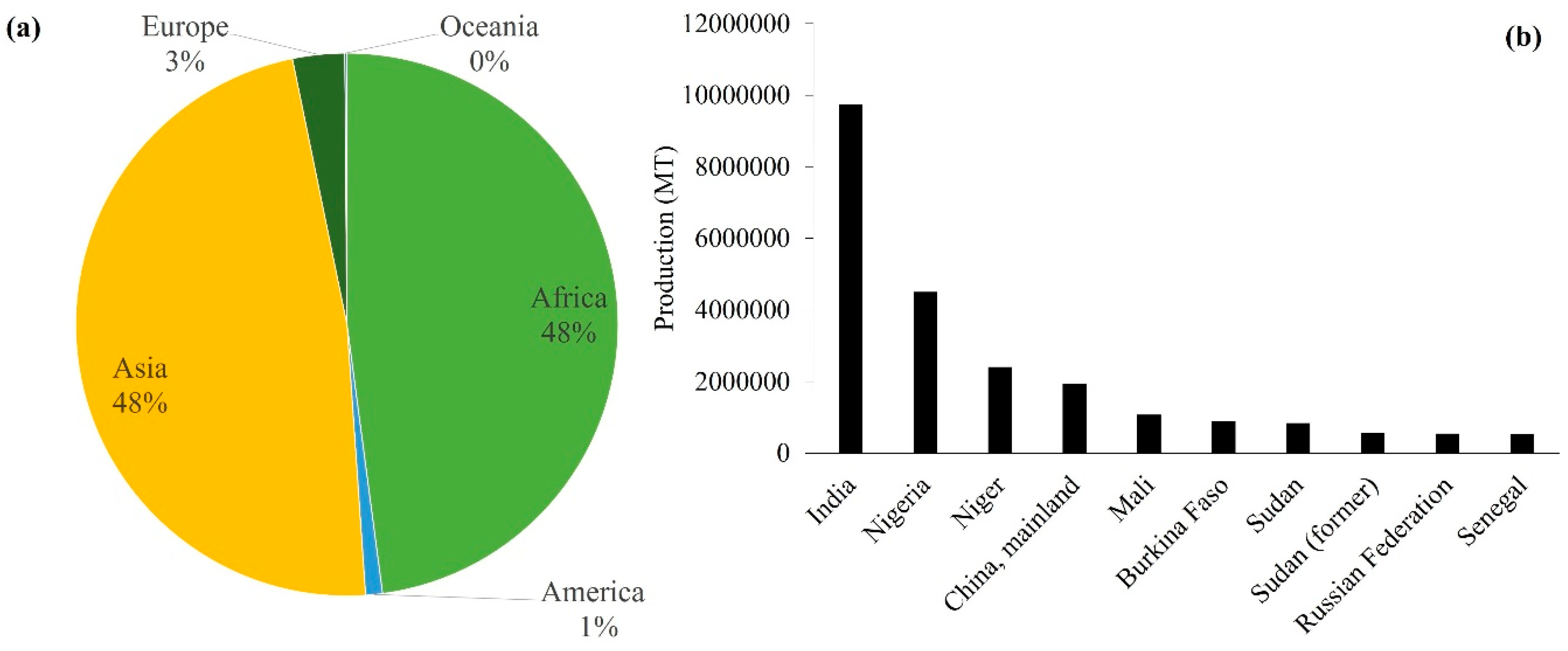
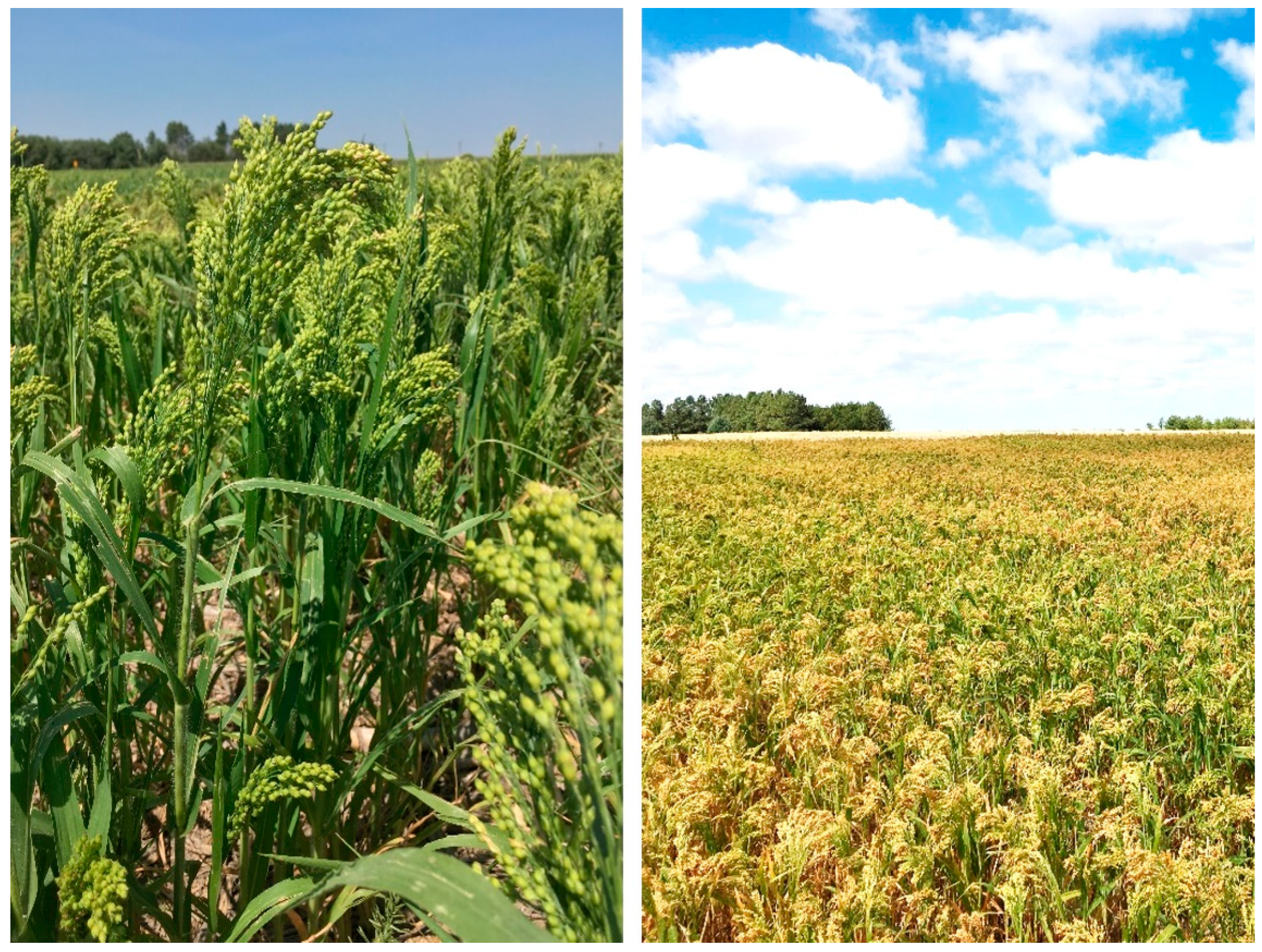
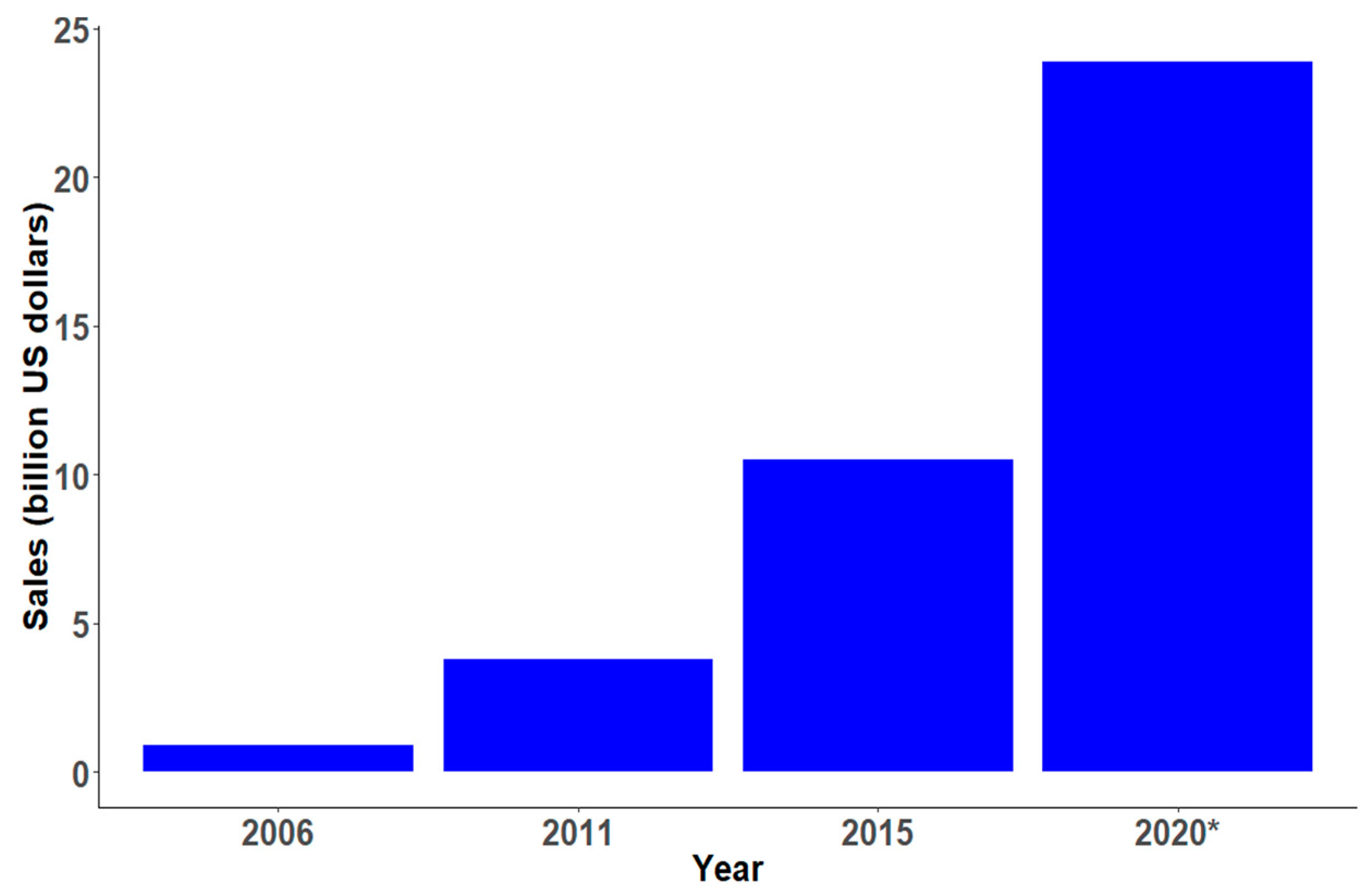
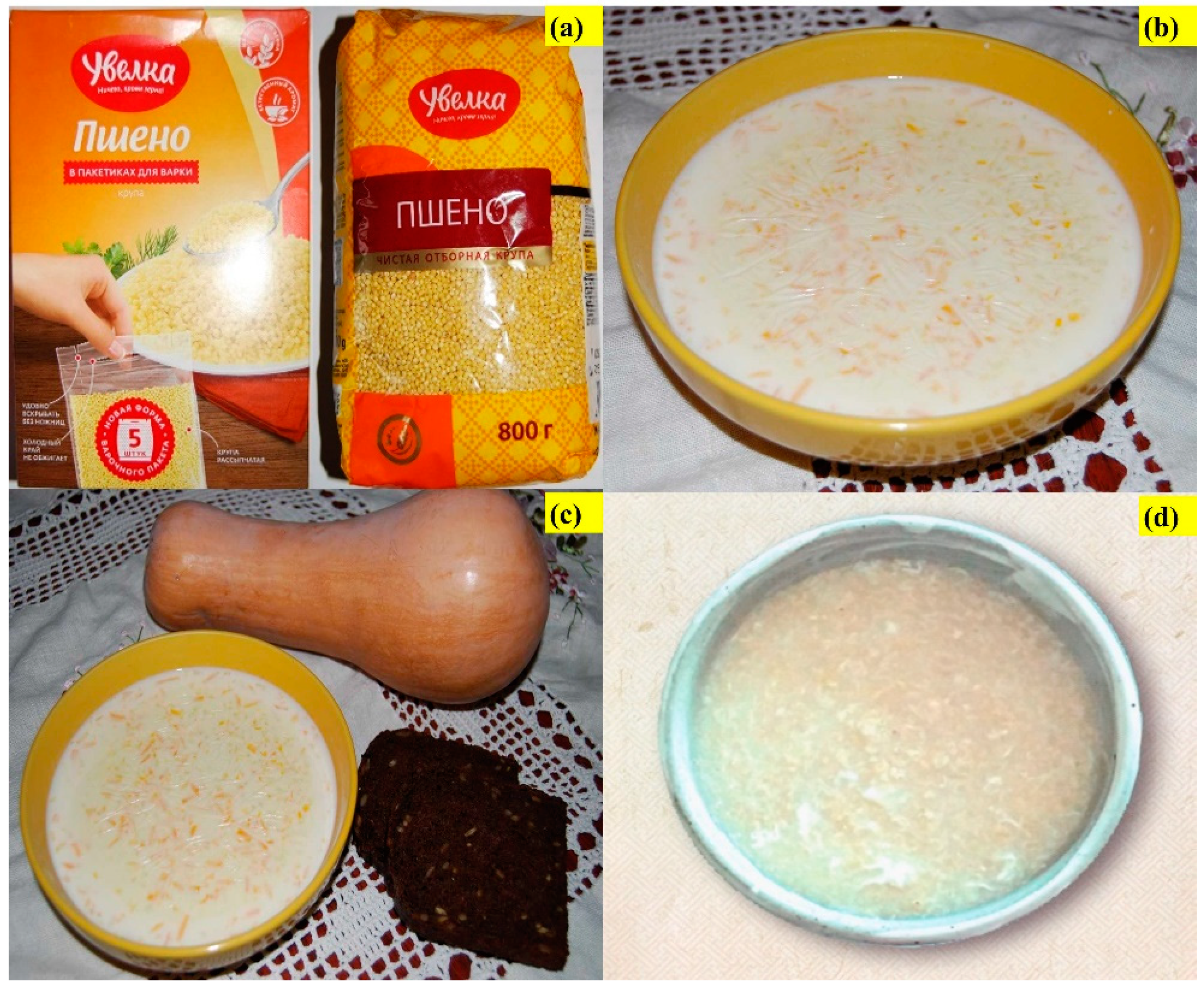
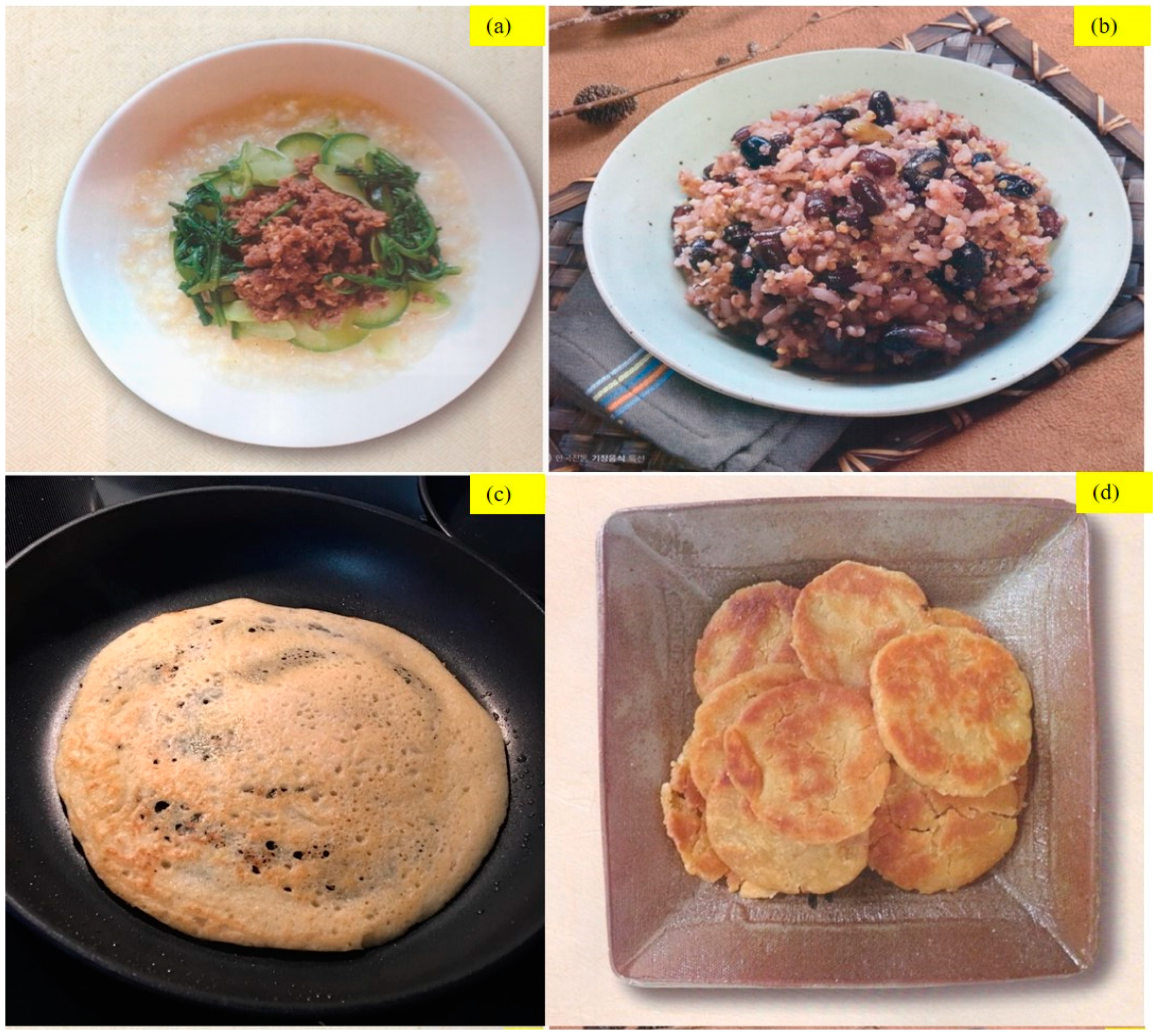
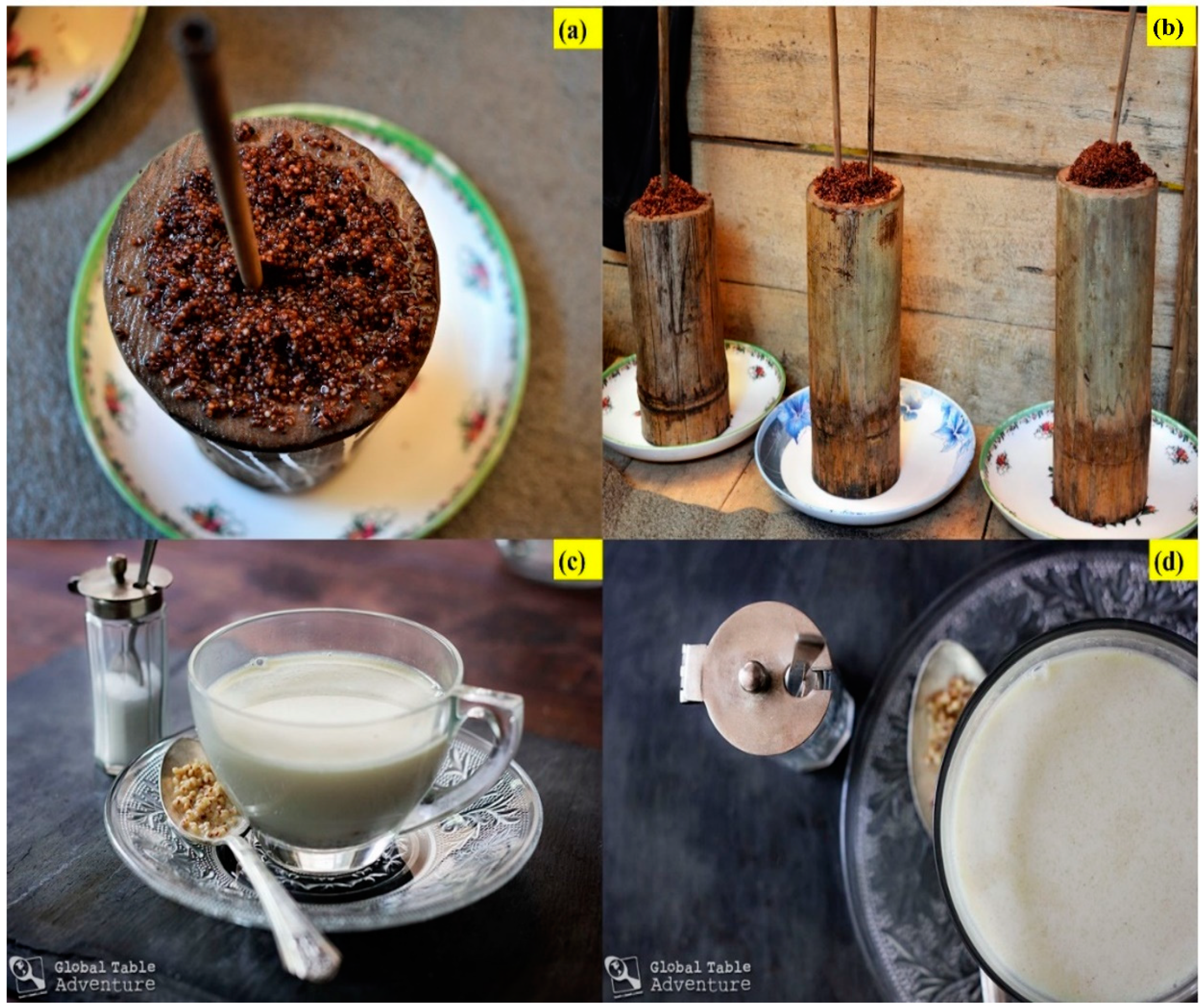
| Crop | Scientific Name | Optimum Soil Type | Altitude Range (m) | Temp. (°C) | pH | Soil Salinity (dS/m) | Rainfall Required (cm) | Maturity Time (days) |
|---|---|---|---|---|---|---|---|---|
| Rice | Oryza sativa L. | HSL | ≥2500 | 21–37 | 6.5–8.5 | <3.0 | 100–300 | 100–160 |
| Wheat | Triticum aestivum L. | LC or HL | ≥2500 | 1.3–35 | 6.0–7.0 | 6.0 | 30–100 | 90–125 |
| Sorghum | Sorghum bicolor (L.) Moench | C or L | ≥3000 | 7–30 | 5.0–8.0 | 4.0–6.0 | 40–100 | 90–120 |
| Pearl millet | Pennisetum glaucum | LC or SL | ≥2700 | 30–34 | 6.0–7.0 | 11.0–12.0 | 20–60 | 60–70 |
| Finger millet | Eleusine coracana | L | ≥2300 | 26–29 | 4.5–7.5 | 11.0–12.0 | 50–60 | 90–120 |
| Proso millet | Panicum miliaceum | SL, A | 1200–3500 | 20–30 | 5.5–6.5 | 1.5–9.5 | 20–50 | 60–90 |
| Foxtail millet | Setaria italica (L.) P. Beauvois | SL | ≥2000 | 5–35 | 5.5–7.0 | 6.0 | 30–70 | 75–90 |
| Barnyard millet | Echinochloa, E. frumentacea (Indian barnyard millet) and E. esculenta (Japanese barnyard millet), | HSL | ≥2000 | 15–33 | 4.6–7.4 | 3–5 | – | 45–70 |
| Kodo millet | Paspalum scrobiculatum | F/M Land | ≥1500 | 25–27 | – | – | 80–120 | 100–140 |
| Little millet | Panicum sumatrense | – | ≥2100 | – | – | – | – | 80–85 |
| Corn | Zea mays | SL | ≤2200 | 25–33 | 5.5–7.0 | 1.7–4.0 | 50–65 | 60–100 |
| Sunflower | Helianthus annuus | SL | – | 21–26 | 6.0–7.5 | – | 50–100 | 80–120 |
| Cereals | Protein (%) | Fat (%) | Crude Fiber (%) | Ash (%) | Starch (%) | Total Dietary Fiber (%) | Total Phenol (mg/100g) |
|---|---|---|---|---|---|---|---|
| Wheat | 14.4 | 2.3 | 2.9 | 1.9 | 64.0 | 12.1 | 20.5 |
| Rice | 7.5 | 2.4 | 10.2 | 4.7 | 77.2 | 3.7 | 2.51 |
| Maize | 12.1 | 4.6 | 2.3 | 1.8 | 62.3 | 12.8 | 2.91 |
| Sorghum | 11.0 | 3.2 | 2.7 | 1.8 | 73.8 | 11.8 | 43.1 |
| Barley | 11.5 | 2.2 | 5.6 | 2.9 | 58.5 | 15.4 | 16.4 |
| Oats | 17.1 | 6.4 | 11.3 | 3.2 | 52.8 | 12.5 | 1.2 |
| Rye | 13.4 | 1.8 | 2.1 | 2.0 | 68.3 | 16.1 | 13.2 |
| Finger millet | 7.3 | 1.3 | 3.6 | 3.0 | 59.0 | 19.1 | 102 |
| Pearl millet | 14.5 | 5.1 | 2.0 | 2.0 | 60.5 | 7.0 | 51.4 |
| Proso millet | 11.0 | 3.5 | 9.0 | 3.6 | 56.1 | 8.5 | 13.3 |
| Foxtail millet | 11.7 | 3.9 | 7.0 | 3.0 | 59.1 | 19.1 | 106.0 |
| Kodo millet | 8.3 | 1.4 | 9.0 | 3.6 | 72.0 | 37.8 | 368.0 |
| Cereals | Ca (%) | P (%) | K (%) | Na (%) | Mg (%) | Fe (%) | Mn (%) | Zn (%) | Thiamin (mg/100 g) | Riboflavin (mg/100 g) | Nicotinic Acid (mg/100 g) |
|---|---|---|---|---|---|---|---|---|---|---|---|
| Wheat | 0.04 | 0.35 | 0.36 | 0.04 | 0.14 | 40.10 | 40.00 | 30.90 | 0.57 | 0.12 | 7.40 |
| Rice | 0.02 | 0.12 | 0.10 | 0.00 | 0.03 | 19.00 | 12.00 | 10.00 | 0.07 | 0.03 | 1.60 |
| Maize | 0.03 | 0.29 | 0.37 | 0.03 | 0.14 | 30.00 | 5.00 | 20.00 | 0.38 | 0.14 | 2.80 |
| Sorghum | 0.04 | 0.35 | 0.38 | 0.05 | 0.19 | 50.00 | 16.30 | 15.40 | 0.46 | 0.15 | 4.84 |
| Barley | 0.04 | 0.56 | 0.50 | 0.02 | 0.14 | 36.70 | 18.90 | 23.60 | 0.44 | 0.15 | 7.20 |
| Oats | 0.11 | 0.38 | 0.47 | 0.02 | 0.13 | 62.00 | 45.00 | 37.00 | 0.77 | 0.14 | 0.97 |
| Rye | 0.05 | 0.36 | 0.47 | 0.01 | 0.11 | 38.00 | 58.40 | 32.20 | 0.69 | 0.26 | 1.52 |
| Finger millet | 0.33 | 0.24 | 0.43 | 0.02 | 0.11 | 46.00 | 7.50 | 15.00 | 0.48 | 0.12 | 0.30 |
| Pearl millet | 0.01 | 0.35 | 0.44 | 0.01 | 0.13 | 74.90 | 18.00 | 29.50 | 0.38 | 0.22 | 2.70 |
| Proso millet | 0.01 | 0.15 | 0.21 | 0.01 | 0.12 | 33.10 | 18.10 | 18.10 | 0.63 | 0.22 | 1.32 |
| Foxtail millet | 0.01 | 0.31 | 0.27 | 0.01 | 0.13 | 32.60 | 21.90 | 21.90 | 0.48 | 0.12 | 3.70 |
| Kodo millet | 0.01 | 0.32 | 0.17 | 0.01 | 0.13 | 7.00 | – | – | 0.32 | 0.05 | 0.70 |
| Grain | Isoleucine | Leucine | Lysine | Methionine | Cystine | Phenylalanine | Tyrosine | Threonine | Tryptophan | Valine |
|---|---|---|---|---|---|---|---|---|---|---|
| Sorghum | 245 | 832 | 126 | 87 | 94 | 306 | 167 | 189 | 63 | 313 |
| Pearl millet | 256 | 598 | 214 | 154 | 148 | 301 | 203 | 241 | 122 | 345 |
| Finger millet | 275 | 594 | 181 | 194 | 163 | 325 | - | 263 | 191 | 413 |
| Foxtail millet | 475 | 1044 | 138 | 175 | - | 419 | - | 194 | 61 | 431 |
| Proso millet | 405 | 762 | 189 | 160 | - | 307 | - | 147 | 49 | 407 |
| Little millet | 416 | 679 | 114 | 142 | - | 297 | - | 212 | 35 | 379 |
| Barnyard millet | 288 | 725 | 106 | 133 | 175 | 362 | 150 | 231 | 63 | 388 |
| Kodo millet | 188 | 419 | 188 | 94 | - | 375 | 213 | 194 | 38 | 238 |
| Nutrient | Unit | Proso Millet (Per 100 g) | Quinoa (Per 100 g) |
|---|---|---|---|
| Water | g | 8.67 | 13.28 |
| Energy | kcal | 378 | 368 |
| Energy | kJ | 1582 | 1539 |
| Protein | g | 11.02 | 14.12 |
| Total lipid (fat) | g | 4.22 | 6.07 |
| Ash | g | 3.25 | 2.38 |
| Carbohydrate | g | 72.85 | 64.16 |
| Fiber, total dietary | g | 8.50 | 7.00 |
| Calcium, Ca | mg | 8 | 47 |
| Iron, Fe | mg | 3.01 | 4.57 |
| Magnesium, Mg | mg | 114 | 197 |
| Phosphorus, P | mg | 285 | 457 |
| Potassium, K | mg | 195 | 563 |
| Sodium, Na | mg | 5 | 5 |
| Zinc, Zn | mg | 1.68 | 3.10 |
| Copper, Cu | mg | 0.75 | 0.59 |
| Manganese, Mn | mg | 1.63 | 2.03 |
| Selenium, Se | µg | 2.70 | 8.50 |
| Thiamin | mg | 0.42 | 0.36 |
| Riboflavin | mg | 0.29 | 0.32 |
| Niacin | mg | 4.72 | 1.52 |
| Pantothenic acid | mg | 0.85 | 0.77 |
| Vitamin B-6 | mg | 0.38 | 0.49 |
| Folate, total | µg | 85 | 184 |
| Tryptophan | g | 0.12 | 0.17 |
| Threonine | g | 0.35 | 0.42 |
| Isoleucine | g | 0.47 | 0.51 |
| Leucine | g | 1.40 | 0.84 |
| Lysine | g | 0.21 | 0.77 |
| Methionine | g | 0.22 | 0.31 |
| Cystine | g | 0.21 | 0.20 |
| Phenylalanine | g | 0.58 | 0.59 |
| Tyrosine | g | 0.34 | 0.27 |
| Valine | g | 0.58 | 0.59 |
| Arginine | g | 0.38 | 1.09 |
| Histidine | g | 0.24 | 0.41 |
| Alanine | g | 0.99 | 0.59 |
| Aspartic acid | g | 0.73 | 1.13 |
| Glutamic acid | g | 2.40 | 1.87 |
| Glycine | g | 0.29 | 0.70 |
| Proline | g | 0.88 | 0.78 |
| Serine | g | 0.65 | 0.57 |
| Percentage of Millet | 100% | 75% | 25% | 0% |
|---|---|---|---|---|
| Biscuit | 56.0 | 64.4 | 71.0 | 78.5 |
| Extruded Snacks | 64.7 | 71.7 | 74.5 | 83.8 |
| Porridge | 53.1 | 65.1 | 78.1 | 86.3 |
| Couscous | 50.2 | 58.9 | 66.1 | 79.43 |
© 2019 by the authors. Licensee MDPI, Basel, Switzerland. This article is an open access article distributed under the terms and conditions of the Creative Commons Attribution (CC BY) license (http://creativecommons.org/licenses/by/4.0/).
Share and Cite
Das, S.; Khound, R.; Santra, M.; Santra, D.K. Beyond Bird Feed: Proso Millet for Human Health and Environment. Agriculture 2019, 9, 64. https://doi.org/10.3390/agriculture9030064
Das S, Khound R, Santra M, Santra DK. Beyond Bird Feed: Proso Millet for Human Health and Environment. Agriculture. 2019; 9(3):64. https://doi.org/10.3390/agriculture9030064
Chicago/Turabian StyleDas, Saurav, Rituraj Khound, Meenakshi Santra, and Dipak K. Santra. 2019. "Beyond Bird Feed: Proso Millet for Human Health and Environment" Agriculture 9, no. 3: 64. https://doi.org/10.3390/agriculture9030064
APA StyleDas, S., Khound, R., Santra, M., & Santra, D. K. (2019). Beyond Bird Feed: Proso Millet for Human Health and Environment. Agriculture, 9(3), 64. https://doi.org/10.3390/agriculture9030064





